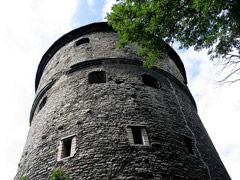Estonia, Real Estate, Tourism
International Internet Magazine. Baltic States news & analytics
Sunday, 06.07.2025, 23:11
Tallinn received material support for reconstruction of tourism attractions
 Print version
Print version |
|---|
| Kiek in die Kök. |
At Tallinn Zoo, an internal exposition of elephants, two observation platforms and an outdoor pool will be built and screens will be installed in order to allow elephants to be viewed outside even when they are in their internal premises. This work represents the first stage in the plan to build an entire house of thick-skinned animals, where elephants, rhinoceroses and hippopotamus will be living, thus creating good exposition possibilities as well as good living conditions for the animals.
Elephants are one of the most watched animals in zoos and the Tallinn Zoo is the most northern location where it is possible to see African elephants and other exotic animals. The exposition of elephants has become a favourite, in particular among Finns and Swedes who comprise the majority of foreign tourists. Currently visitors are only occasionally able to view the elephants. The present elephant house also lacks the conditions required for animal reproduction, although baby elephants would attract even more visitors than adult animals do. The problem is also the occupational safety of attendants related to the constructional peculiarities of the house.
“One of the major problems for our tourism sector is the seasonal nature of tourism. The improvement of the conditions of the zoo is certainly one of the activities intended to reduce it,” said Monica Hankov, Director of the Business Environment Division of Enterprise Estonia.
In the near future, the old city of Tallinn will receive the reconstructed Bastion tunnels and Kiek in die Kök, along with an exposition. The project has the general title "Walk of time" and its objective is to provide a unique destination for persons interested in history, students and tourists. “The expositions use sound, lighting and projection equipment in order to create a profounder impression on the visitors, by communicating information through several senses.
In the exposition of the Bastion tunnels, it is intended to use scenes from different periods of history to allow for immediate experience of the milieu of the corresponding historical period.
The exposition of Kiel in de Kök speaks about the history of fortresses and wars, and weapons are exhibited. It is also planned to furnish part of the storeys as venues for concerts and seminars. In the extension to Kiek in de Kök it is planned, among other things, to offer for viewing, on a large screen, 3D models of the old city of Tallinn and an overview of history as told by the character of Balthasar Russow.
The reconstruction of Kiek in die Kök is already underway, construction commenced in October 2007. To complete the necessary work, it is planned to close the Bastion tunnels to visitors beginning in October 2008, Kiek in die Kök in July 2008 and to reopen them both in July 2009.
The Kihnu museum, which together with the other cultural space of Kihnu belongs to the UNESCO World Heritage List, is established in a school building erected in 1974, which has never been remodelled for use as a museum. Therefore, the possibilities to store and display traditional culture have not been used, to a large extent.
“There is not enough space, the layout and finishing of rooms is not suitable for a museum and the preservation conditions of exhibits do not meet the conditions of today,” said Monica Hankov, characterising the necessity of the project. “In addition to the improved conditions for storing the lore culture, the renovation will also help to make use of the good potential of the museum as a tourism object,” Hankov added.
During reconstruction, the area of rooms will be increased, the room programme of the building will be brought into conformity with the needs of the museum, and the system of heating, ventilation, water and sewerage will be established. The improved preservation conditions permit an increase in the number of exhibits, for example to display once again in the museum the paintings by naivists of Kihnu, which are currently deposited at the Estonian History Museum.
All the projects were supported from the Regional Competitiveness Improvement Programme of Enterprise Estonia, which is co-financed by the European Regional Development Fund. The work related to the elephant house will cost MEEK 32.4, of which the share of support is MEEK 21.9, the project “Time Travel” MEEK 27.3, of which the share of support is MEEK 21, and renovation of the Kihnu museum MEEK 9.7, of which the share of support is MEEK 8.2.
Applications for support from the Regional Competitiveness Improvement Programme of Enterprise Estonia have been accepted since December 2007. Of the structural aid of over BEEK 53 to Estonia in 2007-2013, Enterprise Estonia intends to implement more than BEEK 13. The budget of the Regional Competitiveness Improvement Programme up to 2013 is BEEK 1.5.
The objective of the Regional Competitiveness Improvement Programme is to make the different regions of Estonia more attractive for business operators, investors, qualified labour and visitors. Support from the programme can be applied for by local governments and non-profit associations for the implementation of projects promoting tourism and the recreational industry. For example, applications are awaited for the development of visitor centres, museums, hiking and study trails, and small harbours, for the display of cultural and natural values, and for the establishment of supporting infrastructure of tourist objects. With the help of this programme, local governments can also develop the infrastructure of the local business environment, for example to establish access roads, renovate sewerage systems and take into use again former military, industrial or agricultural objects.








 «The Baltic Course» Is Sold and Stays in Business!
«The Baltic Course» Is Sold and Stays in Business!

